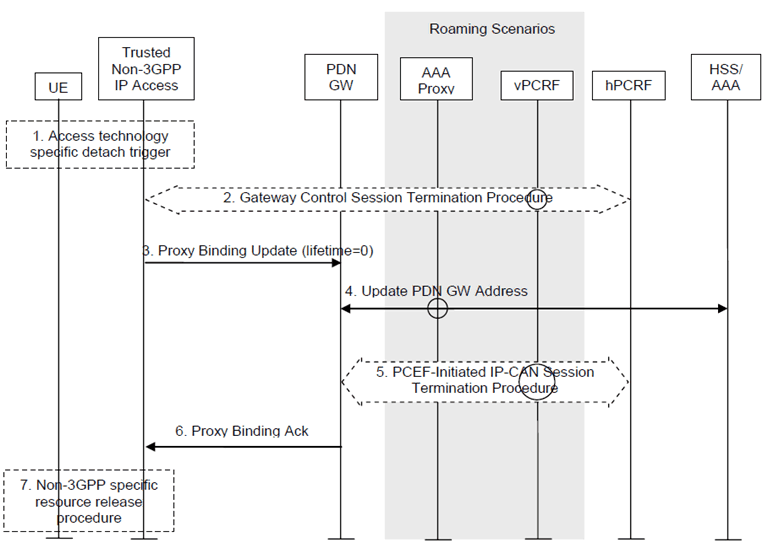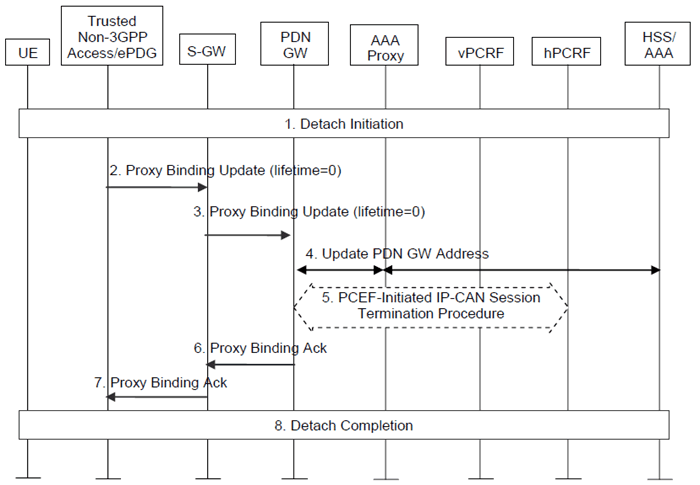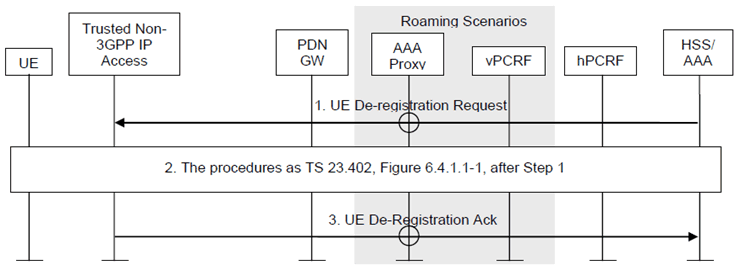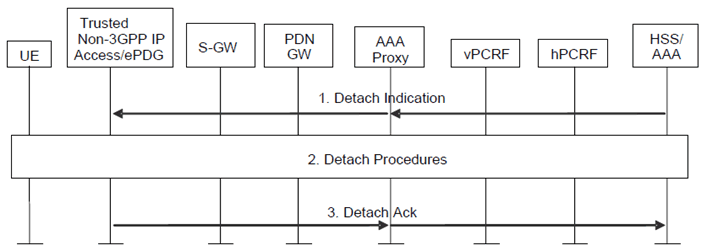Content for TS 23.402 Word version: 18.3.0
0…
4…
4.2…
4.2.2
4.2.3
4.3…
4.4…
4.5…
4.5.7…
4.6…
4.7…
4.7.2…
4.8…
4.8.2a…
4.9…
5…
5.2…
5.4…
5.5
5.6…
5.7…
5.8…
6…
6.2…
6.3
6.4…
6.4.3…
6.5…
6.6…
6.7…
6.8…
6.10…
6.13…
6.15…
7…
7.2…
7.3
7.4…
7.5…
7.6…
7.8…
7.10…
8…
8.2.1.2
8.2.1.3…
8.2.2
8.2.3…
8.2.6…
8.3…
8.4…
8.5…
9…
9.3…
9.4…
10…
13…
16…
16.1.2…
16.1.6…
16.2…
16.2.1a…
16.3…
16.4…
16.7…
16.8…
16.10…
17…
A…
C…
E…
6.4 Detach and PDN Disconnection for S2a
6.4.1 UE/Trusted Non-3GPP IP Access Network Initiated Detach and UE/Trusted Non-3GPP IP Access requested PDN Disconnection Procedure with PMIPv6
6.4.2 HSS/AAA Initiated Detach Procedure with PMIPv6
...
...
6.4 Detach and PDN Disconnection for S2a p. 127
6.4.1 UE/Trusted Non-3GPP IP Access Network Initiated Detach and UE/Trusted Non-3GPP IP Access requested PDN Disconnection Procedure with PMIPv6 p. 127
6.4.1.1 Non-Roaming, Home Routed Roaming and Local Breakout Case p. 127
The procedure in this clause applies to both Detach Procedures, including UE or Trusted non-3GPP access initiated detach procedure, and UE/Trusted non-3GPP Access requested PDN disconnection procedure when supported by the Trusted non-3GPP access.
The UE can initiate the detach procedure, e.g. when the UE is power off. The Trusted Non-3GPP Access Network can initiate the detach procedure due to administrative reasons or detecting the UE's leaving by, e.g. Link-layer event specific to the access technology (refer to PMIPv6 specification, RFC 5213, for more information).

Figure 6.4.1.1-1: UE/Trusted Non-3GPP Access Network initiated detach procedure or PDN-disconnection with PMIPv6
(⇒ copy of original 3GPP image)
(⇒ copy of original 3GPP image)
For detach procedure and in case of connectivity with multiple PDNs, the steps 2 to 6 are repeated for each PDN the UE is connected to.
For UE-requested PDN disconnection procedure, steps 2 to 6 are performed for the PDN that the UE requested disconnection from.
This procedure applies to the Non-Roaming (Figure 4.2.2-1), Roaming (Figure 4.2.3-1) and Local Breakout (Figure 4.2.3-4) cases. For the Roaming and Local Breakout cases, the vPCRF forwards messages between the non-3GPP access and the hPCRF. In the Local Breakout case, the vPCRF forwards messages between the PDN-GW and the hPCRF. In the Roaming and LBO cases, the 3GPP AAA Proxy serves as an intermediary between the Trusted Non-3GPP IP Access and the 3GPP AAA Server in the HPLMN. In the non-roaming case, the vPCRF is not involved at all.
If dynamic policy provisioning is not deployed, the optional steps of interaction between the gateways and PCRF do not occur. Instead, the PDN-GW may employ static configured policies.
Step 1.
The UE or the Trusted Non-3GPP Access Network triggers either detach or disconnection from a specific PDN by an access technology specific procedure. In the case of PDN disconnection of a PDN connection out of multiple PDN connections, the UE shall use the access specific mechanism for differentiating the PDN connections towards the same APN (see clause 6.8.1.1) to indicate the PDN connection to be deregistered and allow the Mobile Access Gateway in the Trusted Non-3GPP IP Access to select the corresponding PDN connection identity needed in step 3 (e.g. the UE informs the Trusted Non-3GPP access of the prefix to be disconnected).
Step 2.
The Trusted Non-3GPP Access Network initiates the Gateway Control Session Termination Procedure with the PCRF as specified in TS 23.203. The Trusted Non-3GPP Access Network no longer applies QoS policy to traffic flows for this UE.
Step 3.
The Mobile Access Gateway (MAG) in the Trusted Non-3GPP IP Access sends a Proxy Binding Update (MN NAI, APN, lifetime=0) message to the PDN-GW with lifetime value set to zero, indicating de-registration. The MN NAI identifies the UE to deregister from the PDN-GW. When only one PDN connection to the given APN is allowed the APN is needed in order to determine which PDN to deregister the UE from, as some PDN-GWs may support multiple PDNs. When multiple PDN connections to the given APN are supported the APN and the PDN connection identity are needed in order to determine which PDN to deregister the UE from.
Step 4.
The PDN-GW informs the 3GPP AAA Server of the PDN disconnection. If the UE no longer has any context in the 3GPP AAA Server, the 3GPP AAA Server notifies the HSS as described in clause 12.1.2.
Step 5.
The PDN-GW deletes the IP-CAN session associated with the UE and executes a PCEF-Initiated IP-CAN Session Termination Procedure with the PCRF as specified in TS 23.203.
Step 6.
The PDN-GW deletes existing entries implied in the Proxy Binding Update message from its Binding Cache and sends a Proxy Binding Ack (MN NAI, APN, lifetime=0) message to the MAG.
Step 7.
Non-3GPP specific resource release procedure is executed. The resources of Trusted Non-3GPP Access Network are released. In case of disconnection from a PDN, if the PDN from which the UE is disconnected was the only PDN that the UE was connected to, detach related procedures may be performed in the Trusted non-3GPP IP access.
6.4.1.2 Chained PMIP-based S8-S2a Roaming Case p. 129
This clause defines the UE/Trusted Non-3GPP IP Access Network-initiated detach procedure UE-requested PDN disconnection procedure for PMIP-based S8-S2a chaining. This procedure also applies to UE/ePDG-initiated detach procedure for PMIP-based S8-S2b chaining.

Figure 6.4.1.2-1: UE/ePDG/Trusted Non-3GPP Access Network initiated detach procedure for chained PMIP-based S8-S2a/b roaming scenarios and PDN-disconnection for chained PMIP-based S8-S2a
(⇒ copy of original 3GPP image)
(⇒ copy of original 3GPP image)
For detach procedure and in case of connectivity with multiple PDNs, the steps 2 to 7 are repeated for each PDN the UE is connected to.
For UE-requested PDN disconnection procedure for chained PMIP-based S8-S2a, steps 2 to 7 are performed for the PDN that the UE requested disconnection from.
Step 1.
For detach, initial steps of the detach is performed as described in steps 1-2 of clause 6.4.1.1 (for trusted non-3GPP access) and step 1 of clause 7.4.1.1 (for untrusted non-3GPP access). For UE-requested PDN disconnection in chained PMIP-based S8-S2a, steps 1-2 of clause 6.4.1.1 are performed.
Step 2.
The MAG in the Trusted Non-3GPP IP Access or ePDG sends a Proxy Binding Update (MN NAI, APN, lifetime=0) message to the Serving-GW with lifetime value set to zero, indicating de-registration. The MN NAI identifies the UE to deregister from the PDN-GW. When only one PDN connection to the given APN is allowed the APN is needed in order to determine which PDN to deregister the UE from, as some PDN-GWs may support multiple PDNs. When multiple PDN connections to the given APN are supported the APN and PDN connection identity are needed in order to determine which PDN to deregister the UE from.
Step 3.
The Serving-GW deletes all existing entries implied in the Proxy Binding Update message from its Binding Cache and releases all associated resources (e.g. GRE tunnel), and then sends a corresponding Proxy Binding Update message (as in step 2) to the PDN-GW in the HPLMN.
Step 4.
The PDN-GW informs the 3GPP AAA Server of the PDN disconnection. If the UE no longer has any context in the 3GPP AAA Server, the 3GPP AAA Server notifies the HSS as described in clause 12.1.2.
Step 5.
The PDN-GW initiates the PCEF-initiated IP-CAN Session Termination Procedure, as specified in TS 23.203.
Step 6.
The PDN-GW deletes existing entries implied in the Proxy Binding Update message from its Binding Cache and releases all associated resources, and then sends a Proxy Binding Ack (MN NAI, APN, lifetime=0) message to the Serving-GW in the VPLMN.
Step 7.
The Serving-GW sends a corresponding Proxy Binding Ack message (as in step 6) to the MAG function in Trusted Non-3GPP IP Access.
Step 8.
The detach procedure is completed as described in step 7 of clause 6.4.1.1 (for trusted non-3GPP access) and step 6 of clause 7.4.1.1 (for untrusted non-3GPP access). In case of disconnection from a PDN, if the PDN from which the UE is disconnected was the only PDN that the UE was connected to, detach related procedures may be performed.
6.4.2 HSS/AAA Initiated Detach Procedure with PMIPv6 p. 130
6.4.2.1 Non-Roaming, Home Routed Roaming and Local Breakout Case p. 130
HSS/AAA-initiated detach procedure with PMIPv6 is illustrated in Figure 6.4.2.1-1. The HSS can initiate the procedure e.g. when the user's subscription is removed. The 3GPP AAA Server can initiate the procedure, e.g. instruction from O&M, timer for re-authentication/re-authorization expired.
If the HSS/AAA-initiated detach procedure has been initiated to delete the UE from the Evolved Packet Core, the HSS/AAA server shall initiate the detach procedure for each of the access systems to which the UE is registered.

This procedure applies to the Non-Roaming (Figure 4.2.2-1), Roaming (Figure 4.2.3-1) and Local Breakout (Figure 4.2.3-4) cases. For the Roaming and Local Breakout cases, the vPCRF forwards messages between the non-3GPP access and the hPCRF. In the Local Breakout case, the vPCRF forwards messages between the PDN-GW and the hPCRF. In the Roaming and LBO cases, the 3GPP AAA Proxy serves as an intermediary between the Trusted Non-3GPP IP Access and the 3GPP AAA Server in the HPLMN. In the non-roaming case, the vPCRF is not involved at all.
Step 1.
The HSS/AAA sends a Detach Indication message to the MAG in the Trusted Non-3GPP Access Network to detach a specific UE.
Step 2.
This includes the procedure after step 1 as in Figure 6.4.1.1-1.
Step 3.
The MAG of the Trusted Non-3GPP Access Network sends a Detach Ack message to the 3GPP AAA Server. If the detach procedure was initiated from the 3GPP AAA Server and if the UE no longer has any context in the 3GPP AAA Server, the 3GPP AAA Server communicates the HSS as described in clause 12.1.2. If the detach procedure was initiated by HSS, the 3GPP AAA Server replies to the HSS as described in clause 12.1.3.
6.4.2.2 Chained PMIP-based S8-S2a Roaming Case p. 131
This clause defines the HSS/AAA-initiated detach procedure for PMIP-based S8-S2a chaining. This procedure also applies for PMIP-based S8-S2b chaining.
If the HSS/AAA-initiated detach procedure has been initiated to delete the UE from the Evolved Packet Core, the HSS/AAA server shall initiate the detach procedure for each of the access systems to which the UE is registered.

Figure 6.4.2.2-1: HSS/AAA-initiated detach procedure for chained PMIP-based S8-S2a/b roaming scenarios
(⇒ copy of original 3GPP image)
(⇒ copy of original 3GPP image)
Step 1.
The HSS/AAA sends a Detach Indication message to the MAG in the Trusted Non-3GPP Access Network or ePDG to detach a specific UE.
Step 2.
The detach procedure as described in steps 2-8 of clause 6.4.1.2 is performed.
Step 3.
The MAG of the Trusted Non-3GPP Access Network or ePDG sends a Detach Ack message to the 3GPP AAA Server. If the detach procedure was initiated from the 3GPP AAA Server and if the UE no longer has any context in the 3GPP AAA Server, the 3GPP AAA Server communicates the HSS as described in clause 12.1.2. If the detach procedure was initiated by HSS, the 3GPP AAA Server replies to the HSS as described in clause 12.1.3.